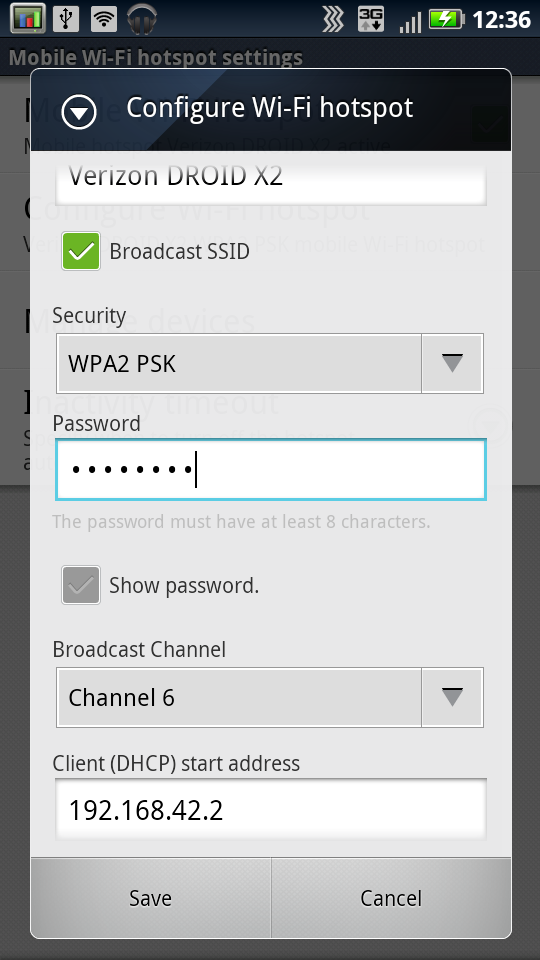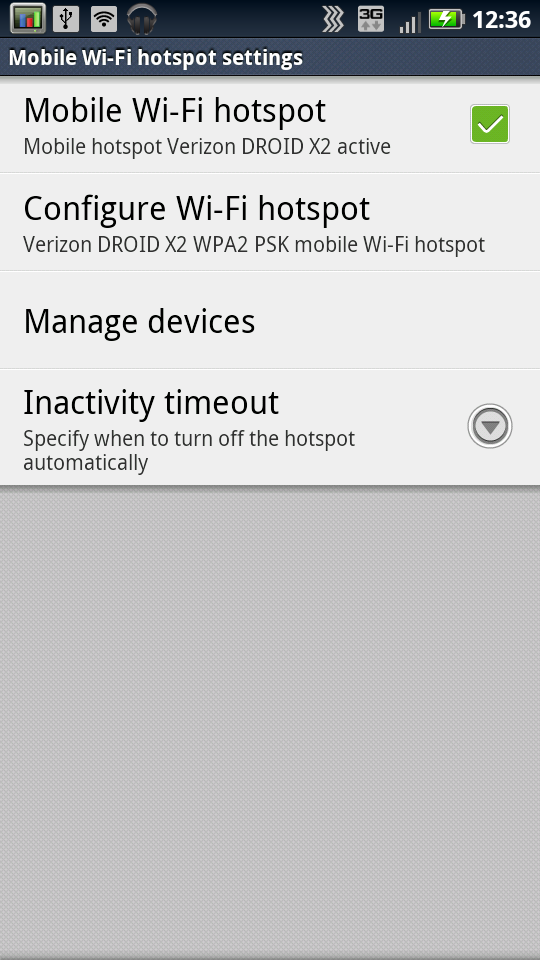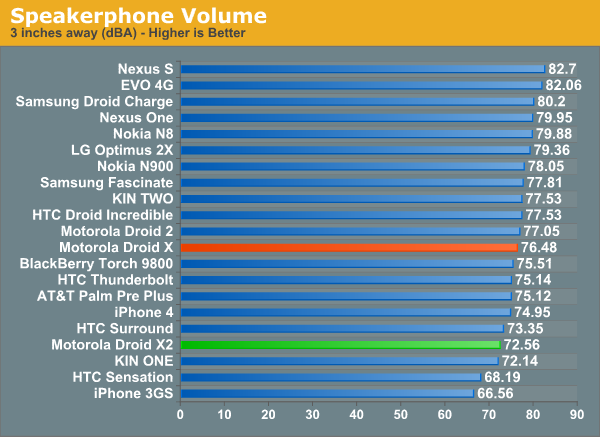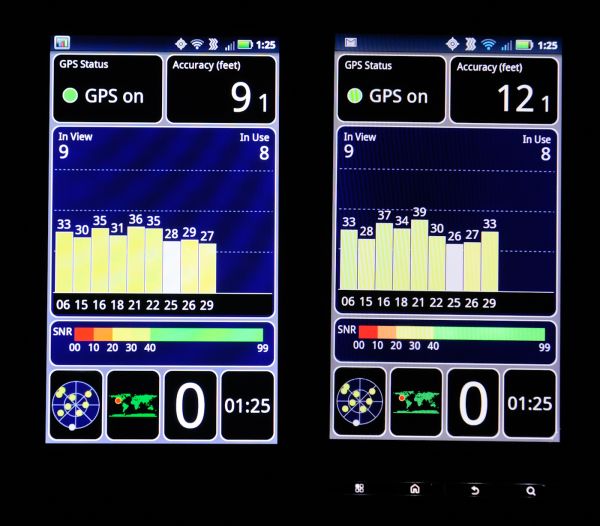Motorola Droid X2 Review - A Droid X with Tegra 2
by Brian Klug on July 7, 2011 8:31 AM ESTWiFi Hotspot
Although the X2 we were sent wasn’t provisioned to use the WiFi hotspot functionality, I could indeed test the settings pages, verify that it worked, and at least get to the Verizon provisioning page. Motorola’s hotspot app lets you change DHCP server settings (or at least define the subnet), and also change the channel, something super important if you’re in a crowded spectrum environment.


Beyond that, I really can’t speak to the hotspot side of things, nor could we run our WiFi hotspot battery life test.
Speakerphone Loudness
Speakerphone on the X2 is a bit disappointing. For all the things that could and should have carried over from the X, speakerphone clearly wasn’t one of them. The actual port on the back of the device is the same as the X, however volume isn’t.

It’s just odd that this isn’t better. I listened to both side by side doing our call test, and the X2 simply isn’t as loud. Having a louder speaker is just so important, especially if you intend to use the device for playing music or frequently using Google Navigation.
Call Quality
Audio quality on the X2 over the earpiece is very good. Similar to other Motorola phones, you can also change the voice coder by dialing ##program, entering “000000,” tapping test mode, going right three pages or so, then changing from EVRC to either EVRC-B, or 13K.
Motorola Droid X2 - EVRC-B by AnandTech
Motorola Droid X2 - 13k by AnandTech
I recorded some examples of the X2’s 1x voice quality by doing line-out to a computer and simply recording. Subjectively I think things sound good, and again the X2 has a second microphone for ambient noise suppression when on calls in loud locations. I was unable to find out what audio codec is inside the X2 for those concerned with how music sounds through the audio jack, though I'd expect similar performance to the original X.
GPS
Finally we have GPS on the X2, which locks extremely quickly and shows similar performance to the original X. I’m not entirely certain, but it’s possible the X2 is using Qualcomm’s GPS on the MDM6600, or at least it would make a lot of sense to. Again, fixes happened extremely quickly on the device when given a good swath of visible sky. Even indoors, the X2 frequently was able to get a good 3D GPS fix, which is more than I can say for a number of other Android handsets.











72 Comments
View All Comments
anandatar - Thursday, July 7, 2011 - link
So yeah, I know, Anandtech is a US blog.Still I'm surprised there is no comparison to the Galaxy S 2 - I was already surprised before by this but nothing has changed.
The main reason is because ALL the phones in the comparison look pale when compared with the S2.
It's (much) faster than any of the Tegra2 based devices.
It has more ram.
It's (much) lighter (there's no xperia either)
It's (much) thinner (there's no xperia either)
it's camera still picture is second to the N8 only
it's camera video recordings are above average (not blowing others out of the water tho - in 1080p it's zoomed and focusing is slower - in 720p its awesome)
it's battery life is (much) improved too
in fact, on the paper, only the resolution (800x480) is lower than the other phones (that sometimes have qHD)
Not only that, but it's also the first phone I'd use instead of an iPhone - it's that much better that it makes sense to switch. But I wouldnt settle for less.
jmcb - Thursday, July 7, 2011 - link
Glad you like the GS2 so much....If you know all this, why do you need to see a comparison? Check other sites, they do compare the GS2 with other phones...Imma help you out.... phonearena is one site that does. phonedog is another...
NeoteriX - Thursday, July 7, 2011 - link
You mentioned in your HTC Sensation review that with a little digging, you were able to come up with the camera sensor used there -- "Samsung’s 8 MP S5K3H1GX 1/3.2” 3264x2488 CMOS sensor with 1.4 µm square pixels "Though the sensor isn't the only thing as you mentioned (lens, etc.), it's useful to compare stated sensitivities, pixel sizes, etc. across the different current phones as well as generationally. I still feel like the gold standard is the iPhone 4 with its 1.75 µm pixel sites and BSI Omnivision sensor.
Do you have this information for the Droid X and X2? How does one generally determine this? I'd love to be able to figure it out for my Evo 3D.
munky - Thursday, July 7, 2011 - link
Iphone4 is by no means the gold standard. Also, there's plenty of variables affecting sensor performance which wouldn't be obvious just by looking at pixel pitch, not to mention how the image processing algorithms affect the final outcome. Unless you suggest AT start evaluating sensors with RAW data a la dxomark, I'd much rather they focus on comparing actual photos as opposed to numerical specs.NeoteriX - Thursday, July 7, 2011 - link
I agree that specs aren't the whole picture, but I do think it provides useful insight to augment the results one sees in practical testing -- things like being able to tell how much of the improvement is image processing, what generation the sensor is and recently of development, and seeing if improving the image quality/sensors used is actually a priority for certain manufacturers. More information never hurts and it helps understand the story -- for example, when digital cameras were undergoing the megapixel race one or two years ago, it was clear that low light quality was degrading and pixel sites helped explain that story.At any rate, I'm no expert on the state of cellphone cameras, but I will respectfully disagree with you on the iPhone 4 -- no other non-camera-phone smartphone (i.e., the Sony/Nokia/etc. type phones with real digital camera level optics and sensors built in, xenon-flashes the whole 9 yards) *I've seen* has the kind of low-light sensitivity and all-around flexibility of the iPhone 4.
It's likely a combination of the relatively large sensor sites, the large fixed aperture of the lens, the BSI CMOS design, and good image processing, but Android mfrs still have their work cut out for them over a year after the iPhone 4 release -- I'd be interested in hearing what other phone is better in low-light and all-around capability, because I certainly haven't seen it.
Exodite - Thursday, July 7, 2011 - link
The new Xperia series (arc/neo/pro/play) seems a good fit, especially considering that the iPhone 5 is slated to use the same sensor as those handsets.Anyway the criteria you use for comparison are rather humorous, as it reads like the iPhone 4 having the best camera - as long as you disregard those that are better?
HTC is generally known to ship shitty cameras but I'd say both foo, bar, beep and bloop - to name those at the top of my mind - offer some excellent solutions for those who want decent images from their smartphones.
(As a side note to Anandtech - your spam filter sucks! Horribly.)
Exodite - Thursday, July 7, 2011 - link
Feel free to replace foo, bar, beep and bloop with the names of big smartphone manufacturers that aren't HTC.I would do it myself, if that wouldn't mean getting caught in the spam filter.
NeoteriX - Thursday, July 7, 2011 - link
That's fair although I wouldn't call my criteria bogus ;)The vast majority of cell/smartphones are those built around sensor/lens/IC SOCs primarily built for mobile applications, they feature LED-based flashes--in essence, they are known to be significant compromises in the world of digital imaging because they are, in other words, phones first, cameras second.
Then, there is a small minority of cell phones that are essentially cameras with phones attached to them -- SonyEricsson C-902, Nokia N82, etc. that feature sensors and lenses pulled from traditional cameras, but with phone functionality -- we're talking about large sensors, camera glass, and xenon flashes intended for P&S digital camera applications and not mobile.
I've heard good things about the new Xperia Arc with the Exmor R BSI sensor, but it hasn't been released in the US yet and neither has the iPhone 5... thus my position that the iPhone 4 leads the pack.
Exodite - Thursday, July 7, 2011 - link
I would say my arc does decent pictures, though perhaps I'm spoiled by the fact that my better half uses a Nokia N8. Color accuracy is good but the focus area is unfortunately very narrow which makes the pictures less good than they could be.The Samsung Galaxy S2 is arguably better, end results considered.
Anyway, I hope the iPhone 5 does end up using the same sensor as the Xperia line as it'd be interesting to see what a different hard/software solution would do with the same sensor.
Then there's stuff like the Motorola Milestone which also have a great camera, considering.
Would an N8 qualify, or is that too a camera first?
Because from my standpoint I can see something like the Altek Leo being a camera first and phone second but I'd still consider anything in a normal housing to be a phone first.
munky - Thursday, July 7, 2011 - link
Have you seen the photos taken with the Nokia N8? They are cleaner that those from iphone4, not to mention more natural looking due to lack of over-sharpening and over-saturation. The iphone4 may be good compared to a crappy phonecam, but it is definitely not the best.